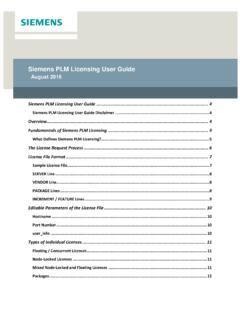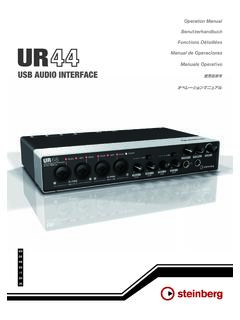Transcription of NETWORKING THE SOLDIER - United States Army
1 NETWORKINGTHE SOLDIERARMY NETWORK CAPABILITY SET MODERNIZATIONAPPROVED FOR PUBLIC RELEASE; DISTRIBUTION IS UNLIMITED. JANUARY 2021 Today, as part of its modernization strategy, the Army is delivering a network that addresses the most critical operational shortfalls and enables Multi-Domain Operations through network capability sets. Capability Sets (CS) and associated technology are fielded on a two-year basis starting in FY21. Each set builds off the previous by adding commercial technology and aligning Army Science & Technology programs for transition into programs.
2 To support this strategy, the Army is executing four network modernization lines of effort to develop and field a network that is more expeditionary and mobile, less complex and better protected. Today, through CS fielding and development, the Army is actively inserting industry capability to enhance the network to give commanders multiple communication choices (both military and commercial networks), make it more user friendly, harden it against cyber and EW threats and provide easier methods to share information with collation partners.
3 DELIVERING THE NETWORKTHE ARMY IS DELIVERING A TACTICAL NETWORK THAT GUARANTEES WE CAN PREPARE FOR WAR AND FIGHT AND WIN AGAINST ANY Army recognized the need to embark on a new network modernization strategy to better keep pace with commercial IT development and to ensure we remain ahead of our adversaries. The Army s approach to tactical network modernization is focused at keeping pace with threats in the near term, while simultaneously developing an optimized future network through rapid insertion of new technology.
4 The strategy contains four supporting efforts focused on institutional reforms, policy and governance, research and development, and more experimental and exploratory science and technology. Today, the Army is executing the strategy by building two-year capability sets and conducting market research to insert the latest commercial capabilities into future sets. EXECUTING THE STRATEGYIn order to incorporate real-time operational feedback and generate less prescriptive requirements, the Army is utilizing the proven industry practice of developmental operations (DevSecOps) and robust operational experimentation, which places developers side-by-side with Soldiers in operational units to evaluate potential technology solutions.
5 Additionally, these developers are working with industry to make real-time program improvements as part of the DevSecOps construct. These assessments will inform Capability Set network design, future capability requirements, resourcing and acquisition decisions, and help the Army and its industry partners to evolve the network at the pace of warfighter demands and commercial 1: UNIFIED NETWORK TRANSPORTWHAT: Establish available, reliable and resilient network that ensures seamless connectivity in any operationally contested.
6 The Army must be able to communicate through an assured network and operate in contested and congested environments. Integrated Tactical Network | Tactical RadiosESB-Enhanced | Tactical Network TransportSignal Modernization/SATCOMLOE 2: COMMON OPERATING ENVIRONMENT (COE)WHAT: Provide a simple, intuitive, single common operating picture through a single mission command suite operated and maintained by : Commanders must be able to make decisions quickly while commanding distributed forces, utilizing rapid decision making skills.
7 Handheld | Mounted | command PostThe Army s network modernization strategy focuses on four modernization priorities, known as lines of effort (LOEs): (1) creating a unified network transport layer; (2) building a common operating environment (COE) for mission command applications; (3) improving Joint Force and Coalition interoperability and (4) improving command posts mobility and NETWORK MODERNIZATION LINES OF EFFORTLOE 3: JOINT INTEROPERABILITY/COALITION ACCESSIBLEWHAT: Ensure Army Forces can more effectively interact (technically and operationally) with Joint and Coalition : The US Army does not fight alone the Army needs to achieve and sustain a level of interoperability within the Army, Joint and Unified Action Partners to enable Joint All Domain command and Control (JADC2).
8 Mission Partner EnvironmentLOE 4: command POST (CP) MOBILITY/SURVIVABILITYWHAT: Enable commanders to lead and fight in their formations from anywhere they choose. Ensure command post deployability, reliability, mobility and : command Posts must be mobile and survivable to meet today s operational needs Fast, Agile, Post Integrated Infrastructure (CPI2)To achieve all-domain dominance, keep pace with industry advancements, and deliver a modernized tactical network, the Army is fielding Capability Sets (CS) in two-year increments.
9 Each CS builds off of the previous and is infused with commercial solutions informed by SOLDIER -led experimentation. Capability Set development will integrate lessons learned from SOLDIER Touchpoints, Project Convergence and other experimentation. Capability Sets will support sensor-to-shooter, IVAS, and Multi-Domain Task Force network needs. The CS construct leverages Army and DoD science and technology initiatives, research and development advancements from industry and academia, and modern commercial off-the-shelf solutions.
10 Building to standard with advanced waveforms, mission command applications, cyber security, data management, satellite communications, and artificial intelligence is core to the success of this phased deliver the network of 2028, the Army outlined four capability sets in Fiscal Years 2021, 2023, 2025, and 2027 to insert technologies that provide warfighters improved capabilities and dominance in a contested and congested environment against any peer or near-peer adversary. Technology insertions will continue beyond 2027 following this same iterative THE TACTICAL NETWORK: CAPABILITY SETS CS23 DELIVERS: Initial commercial SATCOM at-the-halt, providing high capability communications Continued ITN fielding to Infantry and Stryker BCTs.





